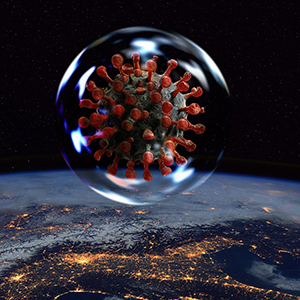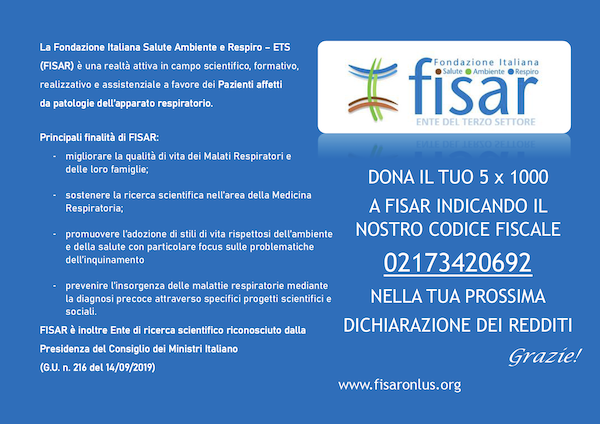Long-lasting dyspnoea in patients otherwise clinically and radiologically recovered from COVID pneumonia: a probe for checking persisting disorders in capillary lung volume as a cause
Keywords:
COVID-19, vascular effects, lung perfusion, capillary blood volume (Vc), carbon monoxide diffusing capacity (DLCO), nitric oxide diffusing capacity (DLNO)Abstract
Background: During SARS-CoV-2 infection, diffuse alveolar damage and pulmonary microvascular abnormalities are critical events that result in gas exchange disorders of varying severity and duration. The only measure of carbon monoxide (CO) diffusing capacity (DLCO) is unable to distinguish the alveolar from the vascular side of present and residual diffusive abnormalities, and measure of NO diffusing capacity (DLNO) is also recommended. Dyspnoea, despite being understudied, persists in a significant proportion of patients for several weeks after hospital discharge. The goal of this study was to look into the underlying cause of long-term dyspnoea in patients who were "clinically and radiologically recovered" from COVID pneumonia by assessing DLCO and DLNO at the same time.
Methods: Patients of both genders, aged ≥18 years, who had a CT scan showing complete resolution of COVID-related parenchymal lesions were recruited consecutively. Spirometrical volumes, blood haemoglobin, SpO2, DLCO, DLNO and capillary blood volume (Vc) were measured. Data from patients without dyspnoea (group A) and from patients still claiming dyspnoea after 12-16 weeks from their hospital discharge (group B) were statistically compared.
Results: Forty patients were recruited: 19 in group A and 21 in group B. Groups were comparable for their general characteristics and spirometrical volumes, that were in the normal range. Mean values for DLCO, DLNO and Vc were significantly and substantially lower than predicted only in patients of group B (p<0.011; p<0.0036; p<0.02; p<0.001, respectively). The DLNO/ DLCO ratio was higher in group B (p<0.001) and inversely correlated to Vc values (-0.3636).
Conclusions: The single-breath, simultaneous measurement of DLCO, DLNO, and Vc demonstrated that problems with blood gas exchange can persist even after parenchymal lesions have healed completely. Regardless of the normality of spirometric volumes, there was a significant reduction in lung capillary blood volume. In these patients, the cause of long-term dyspnoea may be related to hidden abnormalities in the vascular side of diffusive function. In the near future, novel therapeutic approaches against residual and symptomatic signs of long-COVID are possible.
References
Zhu N, Zhang D, Wang W, Li X, Yang B, Song J, et al. A novel coronavirus from patients with pneumonia in China, 2019. N Engl J Med 2020;382:727-33.
Matricardi PM; Dal Negro RW, Nisini R. The first, comprehensive immunological model of COVID-19: implications for prevention, diagnosis, and public health measures. Pediatr. Allergy Immunol 2020;31:454-70.
Coronaviridae Study Group of the International Committee on Taxonomy of Viruses. The species Severe acute respiratory syndrome-related coronavirus: classifying 2019-nCoV and naming it SARS-CoV-2. Nat Microbiol 2020;5:536-44.
Woelfel R, Corman VM, Guggemos W, Seilmaier M, Zange S, Müller MA, et al. Virological assessment of hospitalized cases of coronavirus disease 2019. medRxiv 2020.03.05.20030502.
Wang D, Hu B, Hu C, Zhu F, Liu X, Zhang J, et al. Clinical characteristics of 138 hospitalized patients with 2019 novel coronavirus-infected pneumonia in Wuhan, China. JAMA 2020;323:1061-9.
Guan W, Ni Z, Hu Y, Liang WH, Ou CQ, He JX, et al. Clinical characteristics of coronavirus disease 2019 in China. N Engl J Med 2020;382:1708-20.
Huang C, Wang Y, Li X, Ren L, Zhao J, Hu Y. Clinical features of patients infected with 2019 novel coronavirus in Wuhan, China. Lancet 2020;395:497-506.
Tian S, Xiong Y, Liu H, Niu L, Guo J, Liao M, et al. Pathological study of the 2019 novel coronavirus disease (COVID-19) through postmortem core biopsies. Mod Pathol 2020;33:1007-14.
Wang J, Hajizadeh N, Moore EE, McIntyre RC, Moore PK, Veress LA, Yaffe MB, et al. Tissue plasminogen activator (tPA) treatment for COVID-19 associated acute respiratory distress syndrome (ARDS): a case series. J Thromb Haemost 2020;18:1752-5.
Hughes JMB, Pride NB. Examination of the carbon monoxide diffusing capacity (DLCO) in relation to its KCO and VA components. Am J Respir Crit Care Med 2012;186:132-9.
Wu X, Lin X, Zhou Y. 3-month, 6-month, 9-month, and 12-month respiratory outcomes in patients following COVID-19 related hospitalization: a prospective study. Lancet Respir Med 2021;9:747-54.
Frija-Masson J, Debray M.P, Gilbert M, Lescure FX, Travert F, Borie R, et al. Functional characteristics of patients with SARS-CoV-2 pneumonia at 30 days post-infection. Eur Respir J 2020;56:2001754.
Mo X, Jian W, Su Z, Chen MU, Peng H, Peng P, et al. Abnormal pulmonary function in COVID-19 patients at time of hospital discharge. Eur Respir J 2020;55:2001217.
Huang Y, Tan C, Wu J, Chen M, Wang Z, Luo L, et al. Impact of coronavirus disease 2019 on pulmonary function in early convalescence phase. Respir Res 2020;1:163.
van den Borst B., Peters JB, Brink M, Schoon Y, Bleeker-Rovers CP, Schers H, et al. Comprehensive health assessment three months after recovery from acute COVID-19. Clin Infect Dis 2020;73:e1089-98.
Guenard H, Varene N, Vaida P. Determination of lung capillary blood volume and membrane diffusing capacity by measurement of NO and CO transfer. Respir Physiol 1987;70:113-20.
Borland CDR, Hughes JMB. Lung diffusing capacities (DL) for nitric oxide (NO) and carbon monoxide (CO): The evolving story. Compr Physiol 2020;10:73-97.
Gibson QH, Roughton FJW. The kinetics and equilibria of the reactions of nitric oxide with sheep haemoglobin. J Physiol 1957;136: 507-24.
Barisone G, Brusasco V. Lung diffusing capacity for nitric oxide and carbon monoxide following mild-to-severe COVID-19. Physiol Rep 2021;9:e14748.
Borland CD, Dunningham H, Bottrill F, Vuylsteke A, Yilmaz C, Dane DM, et al. Significant blood resistance to nitric oxide transfer in the lung. J Appl Physiol (1985) 2010;108:1052-60.
Zavorsky GS, Hsia CCW, Hughes MB, Borland CDR, Hervé Guénard H, van der Lee I, et al. Standardisation and application of the single-breath determination of nitric oxide uptake in the lung. Eur Respir J 2017;49:1600962.
Roughton FJ, Forster RE. Relative importance of diffusion and chemicalreaction in determining rate of exchange of gases in the human lung. J Appl Physiol 1957;11:290-302.
Graham BL, Brusasco V, Burgos F, Cooper BG, Jensen R, Kendrick A, et al. ERS/ATS standards for single-breath carbon monoxide uptake in the lung. Eur Respir J 2017;49:1600016.
Mahler DA, Wells CK. Evaluation of clinical methods for rating dyspnoea. Chest 1988;93:580-6.
National Institute for Health and Care Excellence, Scottish Intercollegiate Guidelines Network, Royal College of General practitioners. COVID-19 rapid guideline managing the long-term effects of COVID-19. 2020. Accessed on: April 30, 2022. Available from: https://www.nice.org.uk/guidance/ng188
Soriano JB, Murthy S, Marshall JC, Relan P, Diaz JV, WHO Clinical Case Definition Working Group on Post-COVID-19 Condition. A clinical case definition of post-COVID-19 condition by a Delphy consensus. Lancet Infect Dis 2022;22:e102-7.
Huang L, Yao Q, Gu X. 1-year outcomes in hospital survivors with COVID-19: a longitudinal cohort study. Lancet 2021;398:747-58.
Lerum TV, Aalokken TM, Bronstad E, Aarli B, Ikdahl E, Lund KMA, et al. Dyspnoea, lung function and CT findings 3 months after hospital admission for COVID-19. Eur Respir J 2020;57:2003448.
Huang L, Li X, Gu X, Zhang H, Ren L, Guo L, et al. Health outcomes in people 2 years after surviving hospitalisation with COVID-19: a longitudinal cohort study. Lancet Respir Med 2022;10:863-76.

Published
Issue
Section
License
Copyright (c) 2022 The Author(s)

This work is licensed under a Creative Commons Attribution-NonCommercial 4.0 International License.
Mattioli 1885 has chosen to apply the Creative Commons Attribution NonCommercial 4.0 International License (CC BY-NC 4.0) to all manuscripts to be published.





